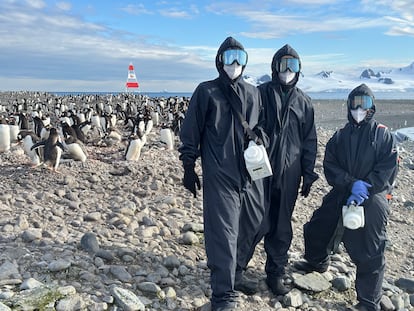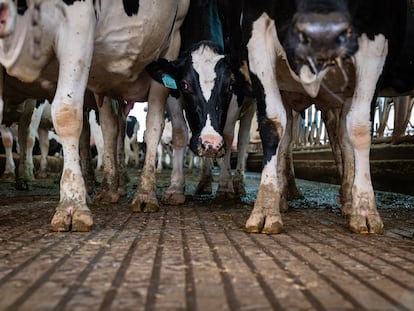Worst avian flu crisis ever recorded spreads across Antarctica
A Spanish expedition finds the potentially lethal virus ‘in all animal species detected at each site’


The highly pathogenic avian influenza virus, which has caused the death of hundreds of millions of birds in the last five years around the world, is spreading across Antarctica, a pristine paradise for wildlife. An expedition led by Spanish virologist Antonio Alcamí has confirmed the presence of the virus “in all animal species detected at each site” on six islands in the north of the Antarctic Peninsula, according to a report sent to the Spanish Polar Committee and international authorities. The good news is that penguins appear to be more resistant than feared, but the pathogen is wreaking havoc on other species. On Joinville Island, scientists have observed that the virus has attacked crabeater seals “with particular virulence.”
Alcamí himself, along with his colleague Ángela Vázquez, were the first researchers to detect the lethal pathogen in Antarctica, exactly one year ago. The virologist, from the Severo Ochoa Molecular Biology Center (CBM) in Madrid, had feared “a disaster” following the Antarctic winter, during which months of total darkness prevent scientists from studying what is happening on the continent. A month ago, Alcamí embarked on a new expedition, crossing the perilous Drake Passage from South America aboard the Australian sailboat Australis, with a mobile laboratory on board.
The team has already detected the virus in 28 carcasses of half a dozen different species: Antarctic pigeons, kelp gulls, crabeater seals, gentoo penguins, Adélie penguins and skuas, a migratory seabird. Alcamí‘s report, to which EL PAÍS has had access, warns that “the viral load in the dead animals is very high, which indicates a risk of exposure to the virus in the vicinity of the carcasses.”
The group has also observed the pathogen in 14 living specimens. “We have not seen signs of illness in penguins, but we have found the virus in dead animals of many species, and also in live penguins that we are sampling. Although we have not seen symptoms in some penguin colonies, the virus is circulating,” Alcamí explains to this newspaper, with two journalists deployed to the Spanish Gabriel de Castilla Antarctic Base, operated by the Spanish army. The researchers have detected the pathogen even in air samples taken in the penguin colonies, warns the report, sent to the Scientific Committee for Research in Antarctica, an international body.
Alcamí's team warns that the presence of the virus in colonies of apparently healthy penguins “has implications for human safety,” since many of these places are regularly visited by both scientists and tourists. The jump of highly pathogenic avian influenza to people is one of the worst nightmares for virologists, but at the moment the virus is not easily transmitted between humans. The World Health Organization has recorded 23 cases of infected people and eight deaths in the last five years, when the virus emerged in poultry and spread successfully in nature.
Last summer, scientists at Cornell University confirmed that the virus, which had been invading dairy farms in the United States for months, was jumping from cow to cow, and from cattle to cats. The researchers issued an alert. “Efficient and sustained mammal-to-mammal transmission is unprecedented. It is worrisome because it may cause the virus to adapt, enhancing its infectivity and transmissibility to other species, including people,” they warned in an urgent study.
Alcamí managed to obtain funding for his expedition in extremis thanks to the mediation of the president of the Spanish National Research Council (CSIC), Eloísa del Pino, who obtained a donation of almost €300,000 from the Spanish Union of Insurers and Reinsurers (UNESPA). After taking samples in the Weddell Sea, the so-called CSIC-UNESPA Antarctic Expedition will continue for a couple of weeks searching for infected animals in the southern Antarctic Peninsula.
Sign up for our weekly newsletter to get more English-language news coverage from EL PAÍS USA Edition
Tu suscripción se está usando en otro dispositivo
¿Quieres añadir otro usuario a tu suscripción?
Si continúas leyendo en este dispositivo, no se podrá leer en el otro.
FlechaTu suscripción se está usando en otro dispositivo y solo puedes acceder a EL PAÍS desde un dispositivo a la vez.
Si quieres compartir tu cuenta, cambia tu suscripción a la modalidad Premium, así podrás añadir otro usuario. Cada uno accederá con su propia cuenta de email, lo que os permitirá personalizar vuestra experiencia en EL PAÍS.
¿Tienes una suscripción de empresa? Accede aquí para contratar más cuentas.
En el caso de no saber quién está usando tu cuenta, te recomendamos cambiar tu contraseña aquí.
Si decides continuar compartiendo tu cuenta, este mensaje se mostrará en tu dispositivo y en el de la otra persona que está usando tu cuenta de forma indefinida, afectando a tu experiencia de lectura. Puedes consultar aquí los términos y condiciones de la suscripción digital.
More information
Archived In
Últimas noticias
The complicated life of Francesca Albanese: A rising figure in Italy but barred from every bank by Trump’s sanctions
Pinochet’s victims grapple with José Antonio Kast’s rise in Chile
Reinhard Genzel, Nobel laureate in physics: ‘One-minute videos will never give you the truth’
From digital curfews to blocking apps: How technology experts protect their children online
Most viewed
- Why we lost the habit of sleeping in two segments and how that changed our sense of time
- Trump’s obsession with putting his name on everything is unprecedented in the United States
- Charles Dubouloz, mountaineering star, retires at 36 with a farewell tour inspired by Walter Bonatti
- The Florida Keys tourist paradise is besieged by immigration agents: ‘We’ve never seen anything like this’
- Living in a motorhome due to soaring housing prices in Madrid: ‘I got used to it quickly, but I don’t idealize it’










































